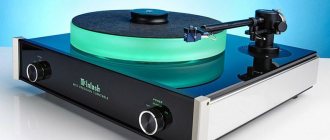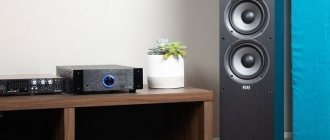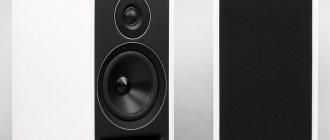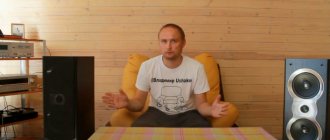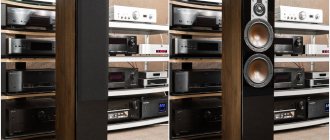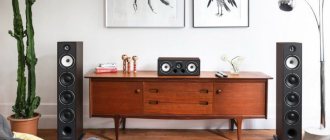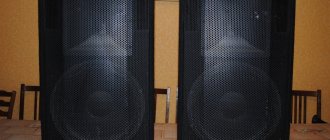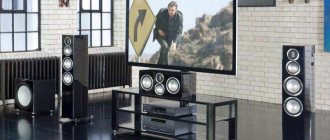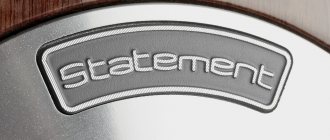Short review
So, what new can we observe? In general, the design of the speakers remained similar to the previous series. There is no need to say much here, just look at the photographs.
From left to right: Q150, Q350, Q550, Q750, Q950. The line also includes the Q650c center channel and Q50a Atmos modules
One of the main changes is that the diffuser of the proprietary coaxial speaker now has stiffening ribs, as in the older R and Reference series, which improve the clarity of mid frequencies. The bass reflex in bookshelf models (calculated using hydrodynamic modeling) moved to the rear wall, which added more integrity to the appearance of the speakers. This may cause dissatisfaction among those who like to move the speakers closer to the wall, but no one bothers to plug the ports with the supplied plugs. The shiny insert with the company logo disappeared, and the logo itself moved to the top edge, again, as in the R series. Bi-amping was removed from the speakers, although, given the budget of the line, there were hardly many owners who needed it.
KEF Q350 rear view
Many people choose acoustics “by the picture,” and KEF understands this very well, trying to make their acoustics look impressive. Frankly, I also love the beautiful look of the speakers, because in a modern interior, “boxes” with classic speakers look a little archaic.
There are only two finishing options so far - in black and matte white. There may be more of them in the future. Grills, which now have a magnetic mount, are, alas, sold separately. At first glance, this is puzzling, but in fact, not everyone will want to hide the stylish appearance of the speakers behind grills. By the way, the new Reference series does not have grills at all, even optionally.
In terms of internal changes, the company points to the addition of a damper tweeter tube and a new low-distortion inductor, as well as wider woofer surrounds that "allow for more accurate low-frequency reproduction at high volume levels." Passive radiators (ABRs) also receive a redesigned suspension that "provides improved controlled and more impressive low frequencies."
To be honest, companies use the word “new” so often in their announcements that you stop paying attention to it, realizing that most often this is a marketing ploy.
The technical characteristics of the new products are almost the same as the old series, but I note that now KEF has begun to indicate honest characteristics of the frequency range at the lower limit, without inflating the numbers, as was the case before.
KEF Q150 Walnut
KEF Q150 is a 2-way bookshelf speaker system from the popular KEF Q series for small spaces.
The KEF Q150 proves that size doesn't always matter. The Uni-Q driver and CFD port allow it to move volumes of air well above its weight. The Q Series bookshelf speakers work great in small spaces. The Uni-Q driver array plus port forward technology (CFD) delivers high resolution and powerful sound.
Q series 2022 from KEF is the 8th generation of the company’s most successful and longest-running series (the first release of the Q series took place in 1991). The series introduced new technological solutions and improvements borrowed from more expensive acoustic lines. The Q series acoustics are 6 models that are suitable for stereo and multi-channel systems. The KEF Q series offers great value for money and sound quality in a modern design that won't date.
Among the new technological solutions of the Q-series:
- New - 11th generation Uni-Q
- New damped tweeter
- More rigid midrange membrane
- New woofer with longer excursion, improved suspension and new diaphragm design
- New ABR (passive bass driver) with long throw and new rubber rear surround
KEF Uni-Q proprietary module
Clear playback with wide polar pattern
The proprietary KEF Uni-Q module is an improved 11th generation driver compared to previous models, responsible for clean and accurate playback. Thanks to this technology, a wide sound distribution pattern is provided, so that the same sound is obtained anywhere in the room. The module also provides uncolored sound.
New damped tweeter
Detail and naturalness of high frequencies
The chisel-shaped rubber damper provides a more gentle dampening of stray sound waves from the rear of the tweeter. It reduces harshness in the lower part of the upper register and provides detail and naturalness in the high frequencies.
New mid/bass driver
The KEF Q series features a new woofer with longer excursion, improved suspension and a new diaphragm design.
The mid/bass driver has a new cone structure. The stiffer material better controls edge frequency resonances, reducing spurious peaks by up to -10 dB compared to the old material, improving intelligibility in the upper midrange.
The new large surround provides longer driver throw for less distortion at higher volumes and improved edge behavior.
Improved centering washer. The stiffness is optimized for less distortion, allowing for more movement and better control. Provides deep and controlled bass that pairs perfectly with the HF in the Uni-Q array
New ABR (passive bass radiator)
Against overtones and noise
The new larger surround provides more travel for greater LF radiator efficiency. The new rear rubber suspension, compared to fabric suspensions, more delicately limits the radiator membrane travel, increasing the maximum SPL without problems with overtones and noise
Works with woofer, provides deeper and more controlled bass, integrates well with Uni-Q module
New bookshelf speaker design
If in previous generations of the series the speaker of bookshelf models was not centered, in the new generation of Q-series bookshelf systems the driver is placed in the center of the front panel. This avoids stray standing waves and reduces resonances inside the cabinet. The bass reflex port is placed rearward. This reduces audible midrange leakage through the bass reflex port, improving intelligibility (port plugs included, if necessary)
The bass reflex port is designed using CFD (Computational Fluid Dynamics) computer simulation. The result is more intelligible mids and controlled bass. The port tip geometry is tuned to minimize turbulence at high levels. Reducing parasitic noise from the port, better work with low frequencies.
Design that never gets old
Q-series speaker systems have a minimalist design that does not become outdated. The speakers are finished in an attractive satin finish and are available in basic colors. The speakers have a seamless front panel joint and magnetic grills (purchased separately).
Characteristics of KEF Q150
- Type: bookshelf passive speaker system (pair)
- Design: 2-way with bass reflex
- 130 mm (5.25″) Uni-Q speaker with aluminum cone
- 25 mm (1″) vented tweeter with aluminum dome cone
- Frequency range when measured in free field (-6dB): 47 Hz
- Frequency response (±3 dB): 51 Hz – 28 kHz
- Crossover frequency: 2.5 kHz
- Amplifier requirements: 10-100 W
- Sensitivity (2.83V/1m): 86dB
- Maximum sound pressure: 108 dB
- Nominal resistance: 8Ω (min. 3.7Ω)
- Weight: 5.6 kg
- Dimensions (H x W x D): 303 x 180 x 278 mm
- Dimensions including rubber feet (H x W x D): 307 x 180 x 278 mm
Personal impressions
First of all, I express my great gratitude to MMC Cinema for providing me with the opportunity to personally familiarize myself with the new Q series a day earlier than the planned event. I would like to note that I did not conduct any detailed tests, time was limited, and there was no opportunity to change components in the paths.
At the time of my arrival at the company's office, the systems had already been assembled in three different rooms. First of all, I proceeded to directly compare the speakers of the old and new lines. The system consisted of junior KEF Q500 and Q550 floorstanders connected to two identical Primare i32 amplifiers for quick switching; the source was the Primare CD32 player; “hoses” (sorry, but there is no other way to call them) Living Atmos were used for connection.
Tracks for listening were used by acquaintances brought with them. I cannot say that there was any big difference in sound between different generations of acoustics. The sound of the old series speakers seemed a little warmer and rollicking, while the new one seemed cooler and more collected. That's all that can be said from the first impression.
When switching between amplifiers, one strange feature emerged: the new series sounded a little quieter, at the same volume level, which is strange - the sensitivity of the acoustics is stated to be the same. Because of this, at first it might seem that the old line sounds better, although this is only a psychological effect. All I had to do was change the volume a couple of decibels, and everything fell into place. Perhaps it was the amplifiers: one could sound louder.
System No. 1. Sorry for the photo quality
The next system is the older KEF Q950 floorstanding speakers, the Primare PRE60 preamplifier, the Primare A60 power amplifier and the same “hoses”. The sound of the system immediately seemed more comfortable, with a pleasant, enveloping bass. Most likely, the preparedness of the room affected it. Unfortunately, I did not hear the expected volume in the sound, which again seemed strange, because... I know the Q series is capable of more. Perhaps the distance to the speakers was too short, or the combination with a class D amplifier does not benefit this acoustics. It's a pity that this time there was no ATI amplifier, which was present in the listening room on my last visit. It would be interesting to compare the sound through it.
System No. 2
I liked the sound of the third system (Thorens vinyl player, pre-Primare PRE32, Primare A34 amplifier, KEF Q350 acoustics, cables of the same diameter) the most. I don’t know what’s wrong this time (the source or the class AB amplifier), but I immediately felt the volume in the sound. The vocalists' voices were localized somewhere in the area of the equipment rack, as it should be, and not from column to column, as on previous systems. In addition, the KEF Q350 bookshelf speakers surprised us with their bass performance even in a spacious room. If it weren’t for time pressure, I would have been happy to listen to this system longer.
System No. 3
Speaker systems KEF Q150
Forced homelessness due to the pandemic around the world has significantly boosted the demand for home entertainment electronics, including inexpensive hi-fi speakers. And in the coronavirus era, such stylish babes suddenly became real hits - and, by the way, not only in our country. Why were they so loved?
Statistics show that since the beginning of the pandemic, sales volumes of all available acoustics have increased almost significantly. Many, having involuntarily become hostages at home, began to more willingly invest money in improving their homes and, in particular, in updating home audio and video equipment. That is why in the European KEF online store the most affordable models of the eighth generation Q-series (they began to be produced, by the way, back in May 2022) have been marked with the Sold Out sticker for several months now.
In Russia you can still buy them freely - they are available in Hi-Fi stores, large retail chains, and popular marketplaces. But this picture is unlikely to last long - we also have an increased demand for junior two-way Q150, which is actually anomalous - Russian music lovers, as you know, have always preferred floor-standing systems, and if they chose shelf systems, they preferred larger models.
It is possible that buyers, when choosing new acoustics for their home, willingly voted in rubles for the laconicism and unusual appearance of the UniQ branded coaxial speakers.
The sudden shooting of the model could be explained by its availability. Indeed, the Russian price for the Q150 now does not exceed 26,000 rubles - it did not change with currency fluctuations, so it now turned out to be even more attractive than the European price (which was kept at 450 euros before the sale of stocks). However, in our electronics supermarkets in the same price category there are a considerable number of cheap floor-standing speakers that sometimes sound absolutely terrible, but look like “real big speakers.” And logically, the Q150 babies should have lost the battle to mediocre consumer goods, but this did not happen. I would like to believe that Russian Hi-Fi buyers have finally begun to select audio equipment not according to the principle of “give me more of everything,” but based on sound quality.
What else could influence success: brand promotion, technical characteristics, special system design, good reviews? Definitely not the first and not the second. The world fame of the British brand certainly played a role, but not the first one - popularity on a wide market is formed by massive advertising support, and there was almost none. The Q150's parameters are more typical than phenomenal. The asset is a wide range and low distortion of the frequency response, but all this with a modest sensitivity of 86 dB.
Design is already warmer. It is possible that buyers, when choosing new acoustics for their home, willingly voted in rubles for the laconicism and unusual appearance of the proprietary UniQ coaxial speakers with lobes inside. They were developed many years ago, but still instantly set Maidstone products apart from other hi-fi speakers. By the way, keep in mind that the Q150 is supplied without grills included - they must be purchased separately.
This is good for those cases when monitors will have to work in tandem with a “sharp” receiver or a cheap source.
Everything finally falls into place when you enter the query “KEF Q150 reviews” into any search engine. It turns out that the kids scored almost the maximum user ratings on all marketplaces! On Yandex.market, the average rating given by KEF Q150 buyers is 4.7 out of 5. And this is a very high score, considering that during the three years of its presence on our market, the model was not presented in magazine reviews. It’s also intriguing that these acoustics (which seem to have the best place in the rear of a multi-channel home theater) are vying with each other for their owners’ praise for musical stereophony. And now we will check this in the reference level system, and at the same time we will share tips on how to better reveal their musicality.
There is no consensus among user reviews regarding the Q150's tonal balance. Some call these systems bright or sharp at high frequencies, while others, on the contrary, soft. The difference in opinions can be explained - these bookshelf fixtures are installed differently and connected to technology, which may have its own character.
Well, let's dot the i's. Our opinion is this: kids don’t have any problems with linearity at HF. There is only some (and seemingly intentional) roll-off at the highest frequencies. This is good for those cases when monitors will have to work in tandem with a “harsh” receiver or a cheap source whose sound is neither pure nor natural. Acoustics will soften dryness and make the sound more flexible and comfortable.
The mids are commendably neutral. The tonal pattern at the junction of the stripes is quite clean, without peaks or valleys.
The mids are commendably neutral. The tonal pattern at the junction of the stripes is quite clean, without peaks or valleys. KEF engineers used the most advanced computational methods to match the emitters in their coaxial heads, and this gave the result - we have one of the most balanced systems in the low-budget class. They can produce a sound with the correct filling of the lower register and with aesthetic elaboration of all the colorful harmonics, if they are connected to a serious system or each link in it is selected. These monitors easily show changes even when replacing any audio cable, so they deserve the most serious attention.
Bass. This is what pleased us with the Q150 from the very first minutes of listening with the Primare i35 Prisma integrated speaker. There was no tightness in the rendering of the relief, no lack of response in the very tectonic lows, no overshoot of the midbass typical for bookshelf speakers (there was only a subtle hint of the boominess of a large bass reflex). If you have an amplifier that has good bass control, then you just need to find the correct position of the speakers on the stands relative to the walls of the room to get a clear bass foundation. And if you have to place it in the classic way, on shelves, close the rear ports and switch to choosing how to fill the shelves with books and experimenting with damping stands for speakers - all this affects the texture in the lower register.
Bass. This is what pleased us with the Q150 from the very first minutes of listening with the Primare i35 Prisma integrated speaker.
Scene. Even when these speakers are placed with a narrow base and close enough to wide reflective surfaces, they are able to create an excellent 3D picture. If the imaginary images are not very physical, and the distant plans are inaccurate, look for the root of the problems at the source. Cheap PVC-insulated cables with a small copper cross-section can also “smear” the picture; the Q150 itself is impeccable in this regard.
The last item on our checklist: dynamics. Here, too, everything is in relative order, if we talk about microdynamics. And the margin for undistorted volume for drivers of such a modest caliber is generally very good (which is again a consequence of high-quality computer modeling of both the suspension and the magnetic head system). If you need to throw a club party at home, they can handle it.
What's the result? Almost all systems cheaper than 300 - 500 euros have certain deviations. That’s why it’s not even interesting to test them, because you have to switch to talking about how the acoustics “recolor” the original sound, which they generally have no right to do. And the KEF Q150 is an exception. They are honest (what you put into them is what you get out of them) and therefore are quite all-genre. They may not reveal all the musical nuances of complex recordings, but in their price category they will bring you closest to understanding the essence of real Hi-Fi. There is little chance of finding monitors with such a thoroughbred sound and at such a price. So the KEF Q150 is a real “Good Buy”.
SYSTEM
- Sources CD player Primare CD35
- Vivo X50 Pro and iPhone 11 smartphones
- laptop Apple MacBook Air A1465
KEF Q150
Manufacturer: KEF Audio Ltd (UK)
www.kef-audio.ru
Configuration: 2 emitters, 2 bands || Acoustic design: bass reflex || Reproducible frequency range: 51 - 28,000 Hz (with unevenness +/-3 dB) || Sensitivity: 86 dB (2.83 V/1 m) || Nominal/Minimum Resistance: 8/3.7 Ohms || Recommended amplifier power: 10 - 100 W || Maximum sound pressure: 108 dB || Finish: black or white satin || Dimensions: 307 x 180 x 278 mm || Weight (single): 5.6 kg || Price per pair: 25,493 .
share
Tags: KEFKEF Q150Good buy
Afterword
Strictly speaking, there will be no special conclusions. The new series plays at the level of the old one or a little differently and “for your money”, and the nuances of sound need to be understood through detailed testing. Another issue is the selection of other components. It seemed to me that Primare amplifiers (especially D-class) are somewhat different from what KEF should be connected to.
Perhaps, by the time of the official audition, something had changed in the presented systems, so I am very interested to know the opinions of those who were there.
This listening once again gave me the idea that high-quality stereo is, first of all, a correctly (and individually!) selected system and a suitable room, and not an expensive path itself and not cables as thick as a well-fed snake.
Once again I express my gratitude to MMS Cinema for organizing an individual acoustic listening experience!
And of course, special thanks to @Katerina for her help with the publication of this article!
